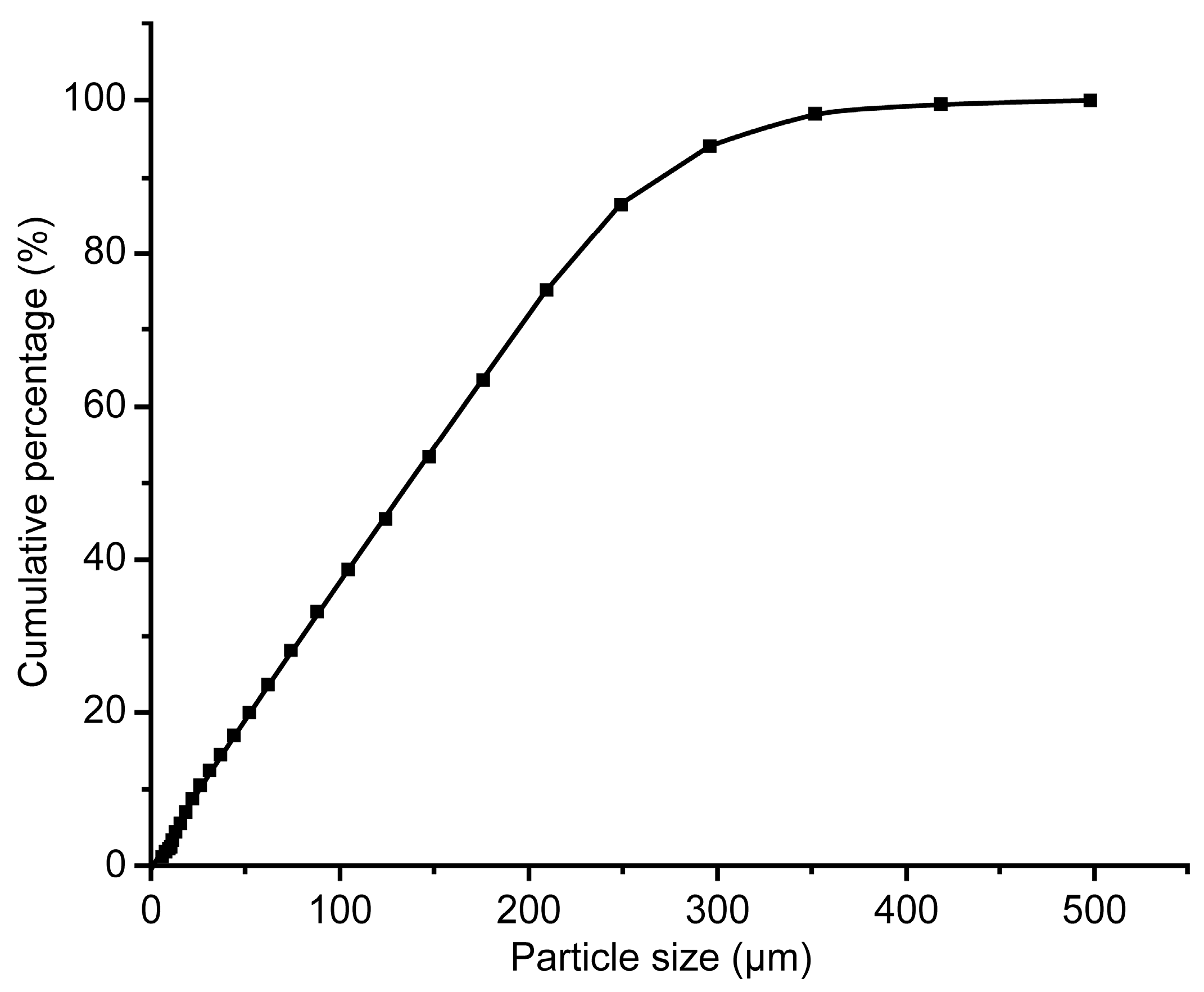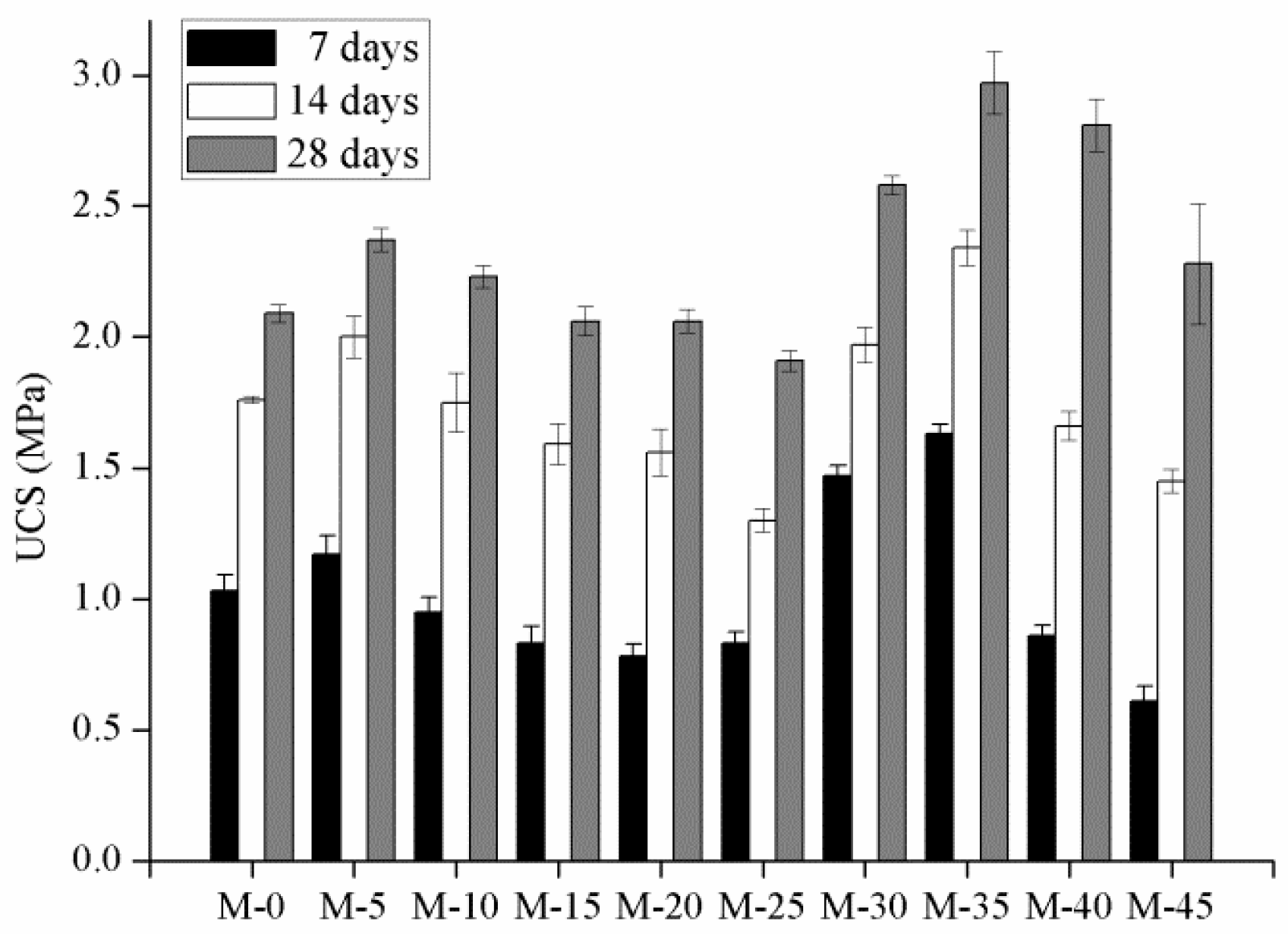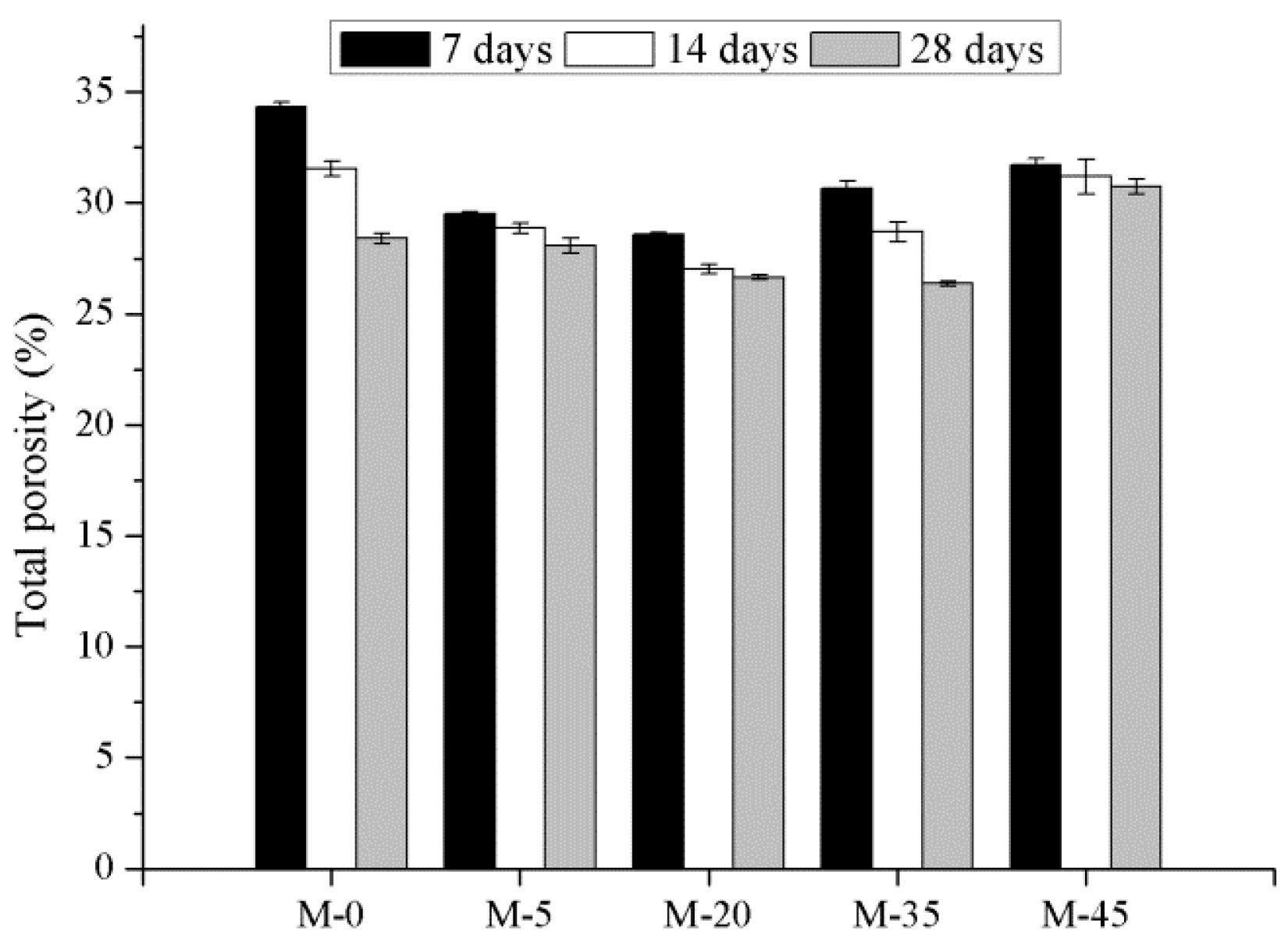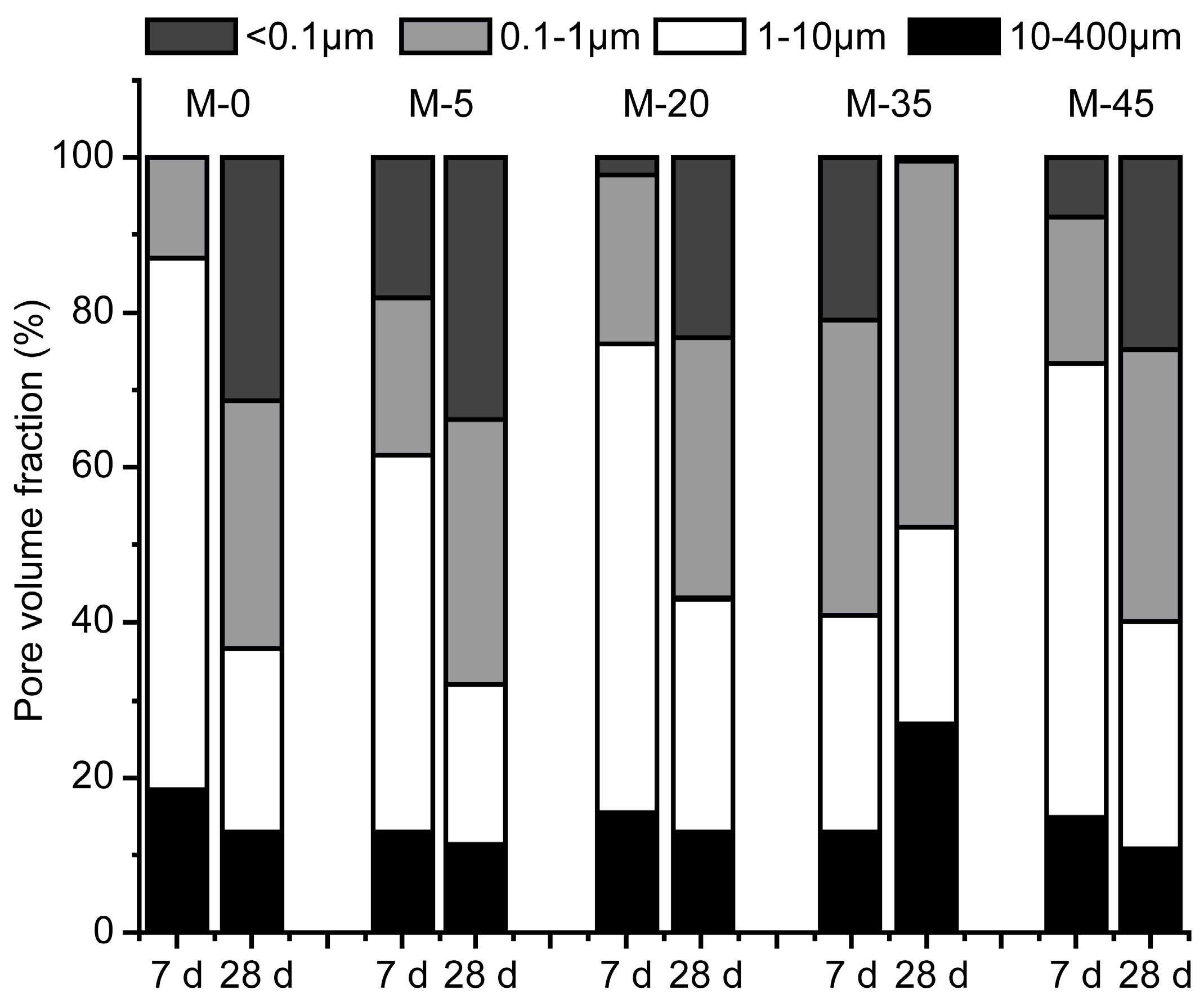Pore Structure Evolution and Its Effect on Strength Development of Sulfate-Containing Cemented Paste Backfill
Abstract
:1. Introduction
- investigation of the dependence of the resulting CPB strength on the initial range of the sulfate content;
- gaining a better understanding of the effects produced by the pores with different radii on the CPB mechanical properties;
- determination of the effects of the CPB curing time on the pore volume variations corresponding to different diameters.
2. Materials and Methods
2.1. Materials
2.1.1. Binder
2.1.2. Tailings
2.1.3. Mixing Water Solutions
2.2. Preparation of Mortar Specimens
2.3. Testing Conditions
3. Results and Discussion
3.1. Effects of Curing Age on Strength Development and Total Porosity of CPB Specimens
3.2. Pore Evolution and Effects of PSDs on UCS
4. Conclusions
- The UCS of the studied mortar samples increased, while their total porosity decreased with an increase in the curing time regardless of the initial sulfate content. The sulfate contents in the CPB specimens equal to 5000 and 35,000 ppm most strongly contributed to their strength development during early curing stages.
- The UCS values can be strongly influenced by the total porosity, but simply determining the total porosity does not sufficiently assess the mechanical strength at a certain curing age. The UCS value also is also related with other factors, such as the amount of the cement and the chemical composition of the mixtures.
- The observed effects of the PSDs on the specimen mechanical properties varied with pore radii. The structures characterized by smaller pore volumes with radii of 1–10 μm and 10–400 μm exhibited higher UCS values.
- An increase in the curing time generally decreased the pore volume of the specimens with pore radii of 10–400 μm and 1–10 μm but increased the pore volume for the specimens with pore radii of 0.1–1 μm and <0.1 μm (except for M-35).
- Future studies are aimed at investigating the resistance of CPB produced from sulfate-rich mixing water to sulfate attack over a curing period of 180/360 days (long-term performance).
Acknowledgments
Author Contributions
Conflicts of Interest
References
- Huang, J.Z.; Wang, J.W. China Association of Resource Comprehensive Utilization. Development Report on Bulk Industrial Solid Waste Comprehensive Utilization; Light Industry Press: Beijing, China, 2009. [Google Scholar]
- Zhang, S.; Xue, X.; Liu, X.; Duan, P.; Yang, H.; Jiang, T.; Wang, D.; Liu, R. Current situation and comprehensive utilization of iron ore tailing resources. J. Min. Sci. 2006, 42, 403–408. [Google Scholar] [CrossRef]
- Sivakugan, N.; Rankine, R.M.; Rankine, K.J.; Rankin, K.S. Geotechnical considerations in mine backfilling in australia. J. Clean. Prod. 2006, 14, 1168–1175. [Google Scholar] [CrossRef]
- Passariello, B.; Giuliano, V.; Quaresima, S.; Barbaro, M.; Caroli, S.; Forte, G.; Carelli, G.; Iavicoli, I. Evaluation of the environmental contamination at an abandoned mining site. Microchem. J. 2002, 73, 245–250. [Google Scholar] [CrossRef]
- Licskó, I.; Lois, L.; Szebényi, G. Tailings as a source of environmental pollution. Water Sci. Technol. 1999, 39, 333–336. [Google Scholar] [CrossRef]
- Yi, Z.L.; Sun, H.H.; Wei, X.Q.; Li, C. Iron ore tailings used for the preparation of cementitious material by compound thermal activation. Int. J. Miner. Metall. Mater. 2009, 16, 355–358. [Google Scholar] [CrossRef]
- Fridjonsson, E.O.; Hasan, A.; Fourie, A.B.; Johns, M.L. Pore structure in a gold mine cemented paste backfill. Miner. Eng. 2013, 53, 144–151. [Google Scholar] [CrossRef]
- Yilmaz, E.; Kesimal, A.; Ercikdi, B. Evaluation of acid producing sulphidic mine tailings as a paste backfill. Turk. J. Earth Sci. Rev. 2004, 17, 11–19. [Google Scholar]
- Berzaazoua, M.; Ouellet, J.; Servant, S.; Newman, P.; Verburg, R. Cementitious backfill with high sulfur content: Physical, chemical and mineralogical characterization. Cem. Concr. Res. 1999, 29, 719–725. [Google Scholar] [CrossRef]
- Benzaazoua, M.; Fall, M.; Belem, T. A contribution to understanding the hardening process of cemented pastefill. Miner. Eng. 2004, 17, 141–152. [Google Scholar] [CrossRef]
- Kesimal, A.; Ercikdi, B.; Yilmaz, E. The effect of desliming by sedimentation on paste backfill performance. Miner. Eng. 2003, 16, 1009–1011. [Google Scholar] [CrossRef]
- Orejarena, L.; Fall, M. Artificial neural network based modeling of the coupled effect of sulphate and temperature on the strength of cemented paste backfill. Can. J. Civ. Eng. 2011, 38, 100–109. [Google Scholar] [CrossRef]
- Ercikdi, B.; Cihangir, F.; Kesimal, A.; Deveci, H.; Alp, I. Utilization of industrial waste products as pozzolanic material in cemented paste backfill of high sulphide mill tailings. J. Hazard. Mater. 2009, 168, 848–856. [Google Scholar] [CrossRef] [PubMed]
- Fall, M.; Célestin, J.C.; Pokharel, M.; Toure, M. Contribution to understanding the effects of curing temperature on the mechanical properties of mine cemented tailings backfill. Eng. Geol. 2010, 114, 397–413. [Google Scholar] [CrossRef]
- Ercikdi, B.; Baki, H.; Izki, M. Effect of desliming of sulphide-rich mill tailings on the long-term strength of cemented paste backfill. J. Environ. Manag. 2013, 115, 5–13. [Google Scholar] [CrossRef] [PubMed]
- Bing, B.; Cohen, M.D. Does gypsum formation during sulphate attack on concrete lead to expansion? Cem. Concr. Res. 2000, 30, 117–123. [Google Scholar]
- Fall, M.; Pokharel, M. Coupled effects of sulphate and temperature on the strength development of cemented tailings backfills: Portland cement-paste backfill. Cem. Concr. Compos. 2010, 32, 819–828. [Google Scholar] [CrossRef]
- Ouellet, S.; Bussière, B.; Aubertin, M.; Benzaazoua, M. Microstructural evolution of cemented paste backfill: Mercury intrusion porosimetry test results. Cem. Concr. Res. 2007, 37, 1654–1665. [Google Scholar]
- Fall, M.; Benzaazoua, M. Modeling the effect of sulphate on strength development of paste backfill and binder mixture optimization. Cem. Concr. Res. 2005, 35, 301–314. [Google Scholar] [CrossRef]
- Common Potland Cement; Chinese Standard: GB/T 175-2007; China Building Material Federation: Beijing, China, 2007.
- Sun, H.H.; Huang, Y.C.; Yang, B.G. Contemporary Cemented Backfill Technology; Metallurgical Industry Press: Beijing, China, 2002. [Google Scholar]
- Standard Test for Cement Density; Chinese Standard: GB/T 208-1994; China National Building Material Group Co. Ltd.: Beijing, China, 1994.
- Ke, X.; Hou, H.; Zhou, M.; Wang, Y.; Zhou, X. Effect of particle gradation on properties of fresh and hardened cemented paste backfill. Constr. Build. Mater. 2015, 96, 378–382. [Google Scholar] [CrossRef]
- Test Method for Fluidity of Cement Mortar; Chinese Standard: GB/T 2419-2005; China Building Material Federation: Beijing, China, 2005.
- Standard for Test Method of Performance on Building Mortar; Chinese Standard: JGJ/T 70-2009; China Architecture & Building Press: Beijing, China, 2009.
- Hassani, F.P.; Ouellet, J.; Hossein, M. Strength development in underground high sulphate paste backfill operation. CIM Bull. 2001, 94, 57–62. [Google Scholar]
- Kesimal, A.; Yilmaz, E.; Ercikdi, B. Evaluation of paste backfill test results obtained from different size slumps with varying cement contents for sulphure rich mill tailings. Cem. Concr. Res. 2004, 34, 1817–1822. [Google Scholar] [CrossRef]
- Tariq, A.; Nehdi, M. Developing durable paste backfill from sulphidic tailings. Waste Res. Manag. 2007, 160, 155–166. [Google Scholar] [CrossRef]
- Cihangir, F.; Ercikdi, B.; Kesimal, A.; Turan, A.; Deveci, H. Utilisation of alkali-activated blast furnace slag in paste backfill of high-sulphide mill tailings: Effect of binder type and dosage. Miner. Eng. 2012, 30, 33–43. [Google Scholar] [CrossRef]
- Ercikdi, B.; Külekci, G.; Yilmaz, T. Utilization of granulated marble wastes and waste wricks as mineral admixture in cemented paste backfill of sulphide-rich tailings. Constr. Build. Mater. 2015, 93, 573–583. [Google Scholar]
- Yu, Z.; Ye, G. The pore structure of cement paste blended with fly ash. Constr. Build. Mater. 2013, 45, 30–35. [Google Scholar] [CrossRef]
- Jiang, L.; Guan, Y. Pore structure and its effect on strength of high-volume fly ash paste. Cem. Concr. Res. 1999, 29, 631–633. [Google Scholar] [CrossRef]
- Li, K.; Zeng, Q.; Luo, M.; Pang, X. Effect of self-desiccation on the pore structure of paste and mortar incorporating 70% GGBS. Constr. Build. Mater. 2014, 51, 329–337. [Google Scholar] [CrossRef]
- Cook, R.A.; Hover, K.C. Mercury porosimetry of hardened cement paste. Cem. Concr. Res. 1999, 31, 933–943. [Google Scholar] [CrossRef]
- Silva, D.A.; John, V.M.; Ribeiro, J.L.D.; Roman, H.R. Pore size distribution of hydrated cement pastes modified with polymers. Cem. Concr. Res. 2001, 31, 1177–1184. [Google Scholar] [CrossRef]





| Component | MgO | Al2O3 | SiO2 | SO3 | CaO | Fe2O3 |
|---|---|---|---|---|---|---|
| wt % | 5.00 | 11.00 | 26.94 | 5.25 | 47.66 | 1.34 |
| Classification | Coarse | Medium | Fine | |||
|---|---|---|---|---|---|---|
| Diameter (mm) | >0.074 | <0.019 | >0.074 | <0.019 | >0.074 | <0.019 |
| wt % | >40 | <20 | 20–40 | 20–55 | <20 | >50 |
| Element Unit | D10 (μm) | D30 (μm) | D50 (μm) | D60 (μm) | D90 (μm) | Gs | Cu | Cc |
|---|---|---|---|---|---|---|---|---|
| Value | 26.16 | 74.00 | 148.00 | 176.00 | 296.00 | 2.85 | 6.73 | 1.20 |
| Name | FeSO4·7H2O (ppm) |
|---|---|
| M-0 | 0 |
| M-5 | 5000 |
| M-10 | 10,000 |
| M-15 | 15,000 |
| M-20 | 20,000 |
| M-25 | 25,000 |
| M-30 | 30,000 |
| M-35 | 35,000 |
| M-40 | 40,000 |
| M-45 | 45,000 |
© 2017 by the authors; licensee MDPI, Basel, Switzerland. This article is an open access article distributed under the terms and conditions of the Creative Commons Attribution (CC-BY) license (http://creativecommons.org/licenses/by/4.0/).
Share and Cite
Rong, H.; Zhou, M.; Hou, H. Pore Structure Evolution and Its Effect on Strength Development of Sulfate-Containing Cemented Paste Backfill. Minerals 2017, 7, 8. https://doi.org/10.3390/min7010008
Rong H, Zhou M, Hou H. Pore Structure Evolution and Its Effect on Strength Development of Sulfate-Containing Cemented Paste Backfill. Minerals. 2017; 7(1):8. https://doi.org/10.3390/min7010008
Chicago/Turabian StyleRong, Hao, Min Zhou, and Haobo Hou. 2017. "Pore Structure Evolution and Its Effect on Strength Development of Sulfate-Containing Cemented Paste Backfill" Minerals 7, no. 1: 8. https://doi.org/10.3390/min7010008
APA StyleRong, H., Zhou, M., & Hou, H. (2017). Pore Structure Evolution and Its Effect on Strength Development of Sulfate-Containing Cemented Paste Backfill. Minerals, 7(1), 8. https://doi.org/10.3390/min7010008





